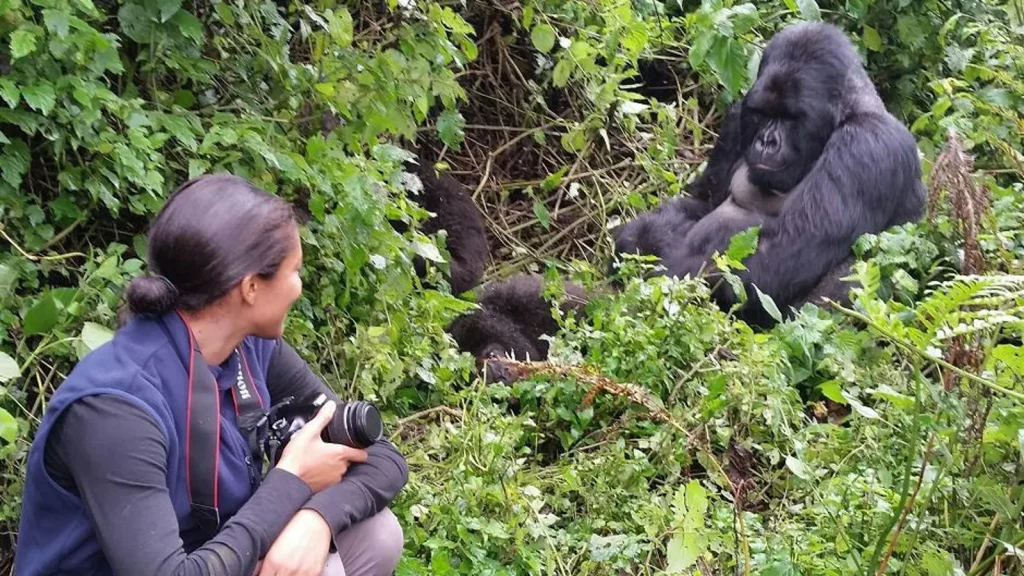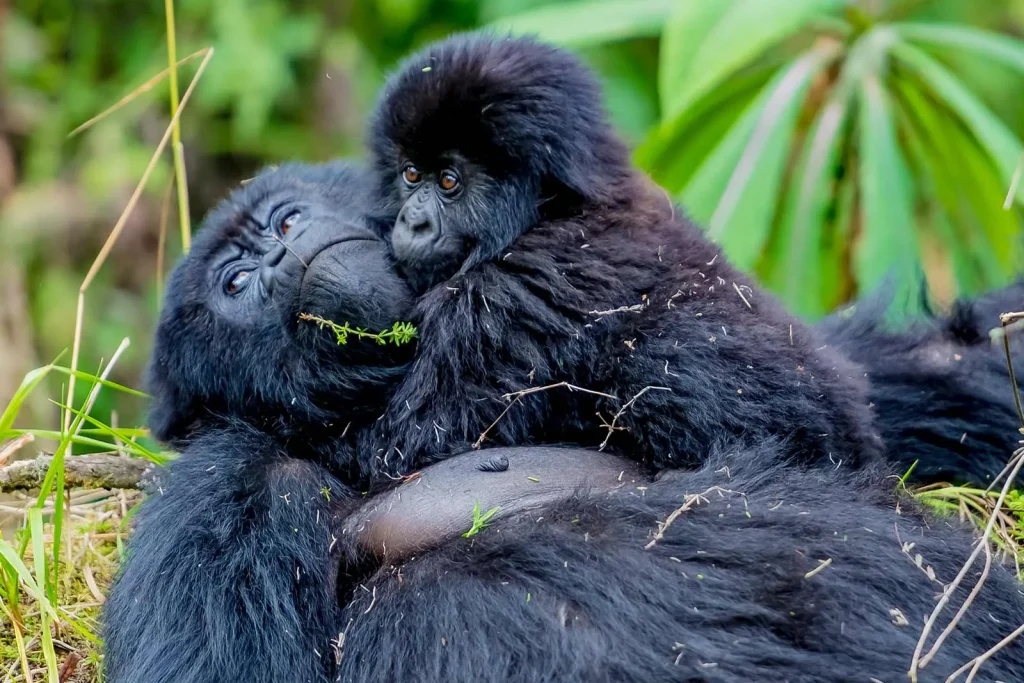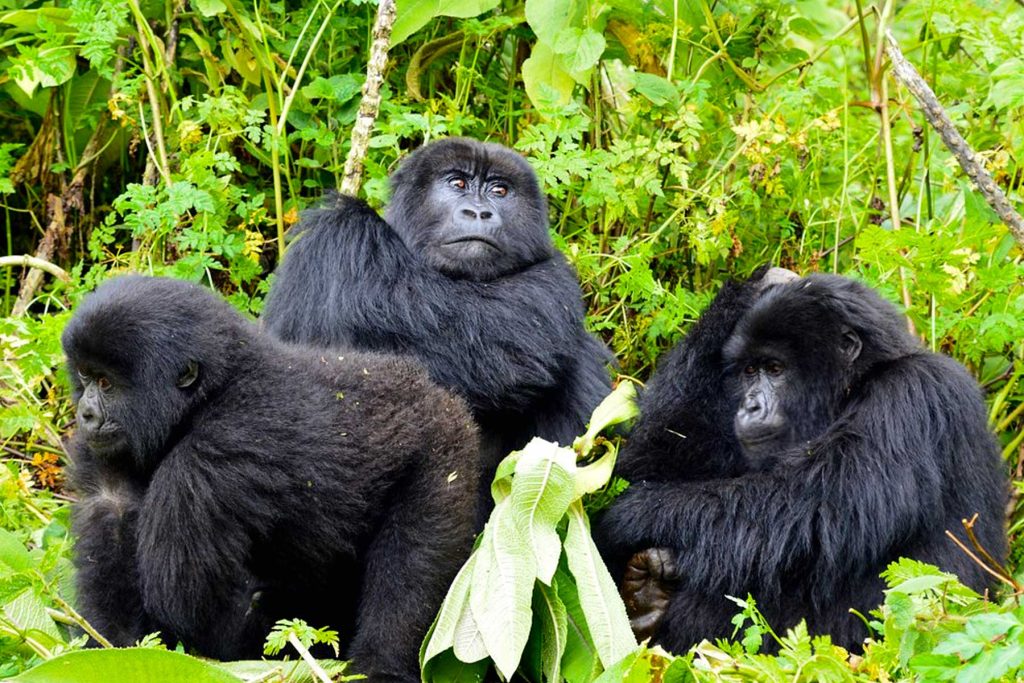Volcanoes National Park
- Updated: 6 months ago
- By Editorial Team
Volcanoes National Park – Safari Tours, Climbing, attractions, When to visit & Location
There’s something about Volcanoes National Park that words can never quite capture—something you only understand when you’re there, standing still, heart open. Maybe it’s the way the morning mist rises like a blessing off the Virunga peaks. Or the sharp, electric moment when a gorilla stirs just beyond the bamboo—close enough to hear, close enough to feel.
Maybe it’s the quiet. Not silence, but a living quiet—where birds call like flutes in the canopy, your boots press softly into damp earth, and every breath feels deeper, fuller, truer as you climb higher into the heart of the forest.
In that stillness, you don’t just see nature. You feel Rwanda breathing.
Perfectly located away in Rwanda’s northwestern corner, Volcanoes National Park is the kind of place that makes you feel small in the best way. Not lost—but part of something bigger.
Whether you’re here for a gorilla trek, a volcano hike, or to connect with Rwanda’s conservation story, this park gives you more than a safari—it gives you presence.
Safari Tours in Volcanoes National Park
This park is home to some of the most sought-after safari experiences in Africa. But don’t expect game drives here—what you’ll find instead are deep, quiet walks that lead to unforgettable encounters.
Here’s what most people come for:
- Gorilla Trekking
This is the parks’ major safari activity. You’ll be assigned to one of 12 habituated gorilla families and hike with expert guides and trackers who know every trail, call, and rustle. The trek can be short or long depending on where the family is, but the reward is always worth it: 60 minutes in the presence of a gorilla group, sometimes just meters away. A silverback. A playful infant. A mother with eyes as calm as the forest. - Golden Monkey Tracking
Smaller and quicker than gorillas, golden monkeys are a joy to watch. They dart through the bamboo, curious and cheeky. The treks are usually easier, making them a great option for families or anyone who wants a more relaxed morning in the forest. - Mount Bisoke Crater Lake Hike
This one-day trek climbs to 3,711 meters, ending at a crater lake that looks like it was dropped from the sky. It’s steep, muddy, and sometimes cloudy—but when the mist clears at the summit, it’s unforgettable. - Mount Karisimbi Hike
This is for the serious hikers because it’s a little more demanding. A two-day trek to the top of Rwanda’s highest peak (4,507 meters). You camp halfway up, sleep under a sky full of stars, and reach the summit at sunrise. It’s not easy—but it’s powerful. - Dian Fossey Tomb Trail
For many, this is an emotional journey. The trail winds through the forest to the Karisoke Research Center ruins, where Fossey lived and worked. Her grave, beside her beloved gorillas, feels quiet and sacred. - Iby’Iwacu Cultural Experience
Just outside the park, this community-run experience gives you a chance to meet former poachers who now work in conservation. Expect dancing, drumming, storytelling, and a genuine window into rural life near the forest.
Volcanoes National Park Gallery
Location – Where Is Volcanoes National Park?
Volcanoes National Park sits in the Rwanda’s northwest corner—just a two-hour, red-soil drive from Kigali—you’ll find Volcanoes National Park, or as many elders still say, “Ruhengeri.” It isn’t just a park; it’s a living memory of Rwanda’s soul.
Here, the Virunga Mountains rise in a sweeping arc shared with Uganda and the DRC with five great peaks—Karisimbi, Bisoke, Muhabura, Gahinga, and Sabyinyo. On clear mornings you see their crowns skimming the clouds; on misty ones they hide, murmuring secrets in Kinyarwanda to those who listen.
Step onto the trail and the forest greets you with a gentle “Muraho.” The air is cool and smells of damp moss, sweet eucalyptus, and a hint of wood-smoke drifting from distant homesteads. Birds call out like tiny intore drummers, and every crunch of your boots feels like turning a page in an unwritten story.
Villagers have lived in these shadows for generations, naming lava flows after heroes and thanking the mountains for harvest rains. Ask your guide and you’ll hear tales of cloud spirits (“imvura y’ikirere”) and evening prayers carried on bamboo leaves. Even with someone leading the way, the place feels untamed, the hours stretching like a slow song played on an old inanga.
Walk a little farther, pause, and you’ll notice time soften around you. That’s the magic of Rwanda’s north: the sense that the forest isn’t waiting for you—it’s simply welcoming you home.
A Brief History of Volcanoes National Park
Volcanoes National Park has a long and important history—not just for Rwanda, but for global conservation.
Back in 1925, long before Rwanda became known for responsible travel or gorilla tourism, this patch of forest was declared protected land. The goal? To shield mountain gorillas from hunters and a disappearing habitat. It was an idea ahead of its time. Decades later, an American woman with a fierce heart and quiet resolve would change the course of its story. Dian Fossey arrived and didn’t just study gorillas—she lived among them. Between Mount Karisimbi and Bisoke, she built the Karisoke Research Center and made these misty slopes her home.
For nearly 20 years, she tracked, observed, and fought—sometimes alone—to save a species on the brink. Her murder in 1985 was a tragedy, but her legacy took root. The world took notice. Rwanda did too.
Today, Volcanoes National Park stands not as a memory of what was lost—but as a beacon of what can be saved. Gorilla numbers are rising slowly, quietly, like the forest itself healing. Villagers who once feared or hunted these creatures now guide visitors to meet them. Schools, health centers, and local jobs now grow from the same soil where poachers once hid.
That’s the Rwandan way—when we heal, we do it together. So when you step into this forest, know that you’re not just entering a park. You’re walking into a living story. One written in Kinyarwanda, in footsteps, in rustling bamboo—and in hope.
How to Get There
From Kigali:
If you’re landing in Kigali, you’re already close—just a scenic 2.5-hour drive stands between you and the misty slopes of Volcanoes National Park. It’s one of the easiest gorilla trekking spots to reach in all of Africa. Most travelers go the stress-free route and book with a local company like Friendly Gorillas Safaris, which takes care of everything: permits, transport, accommodation, and even that early morning coffee before your trek.
Prefer public transport? It’s possible, though a little more adventurous. You can hop on a bus or shared taxi to Musanze town, then grab a motorbike or local taxi to your lodge. But if you’re here to meet gorillas, going with a guide just makes the journey smoother.
Local Tip
Landing late in Kigali? Spend the night in town. Rest, enjoy some brochettes or sambaza, then head to the park fresh the next morning. It makes all the difference.
When’s the Best Time to Visit Volcanoes National Park?
You can come any time of year, but the weather and trail conditions shift with the seasons. Here’s what to expect:
June to September – This is the prime dry season. Trails are firm, the forest is easier to explore, and the skies tend to stay clear. It’s also the busiest season—permits sell out fast, so book early.
December to February – A second dry stretch with cooler mornings. It’s still a great time for trekking, with slightly fewer crowds.
March to May & October to November – These are the wet months. Expect some rain, slippery trails, and the occasional muddy adventure. But the forest? It turns emerald green. It’s quieter, lodges are often more available, and the gorillas? They’re still there, munching bamboo in the rain like it’s a good day for a picnic.
Volcanoes National Park FAQs
How much is a Rwanda gorilla trekking permit?
As of 2025, a single gorilla permit for one person per day costs USD 1,500. This permit is valid per day and may not be re-used after it’s day is gone. Yes, it’s a significant investment—but it’s also a lifeline.
The gorilla permit fee does more than letting you see gorillas, your money helps fund conservation efforts and supports the surrounding communities that help protect these mountain giants.
It’s also important to know that only 96 permits are issued each day, so securing yours early is important—especially during the high seasons.
How fit do I need to be for gorilla trekking in Rwanda’s volcanoes?
Yes, gorilla trekking may be somewhat demanding but, you definitely don’t need to be an athlete, but you do need to be in decent shape.
Some gorilla families are closer, some farther. Treks can range from 30 minutes to 6 hours round-trip.
If you have physical challenges, get in touch with us and we shall arrange an “easier” group to ensure you have a flawless Rwanda gorilla encounter.
What should I wear for the trek?
Long pants, waterproof hiking boots, a long-sleeve shirt, a rain jacket, and gardening gloves for holding onto vines. The forest can be muddy and full of stinging plants. Layers help—mornings are cold, afternoons warm.
Are gorilla sightings guaranteed?
Almost always. Guides track the families daily, and success rates are over 95%. If you’re very unlucky (extremely rare), the park may offer a second chance depending on conditions.
Can children trek gorillas?
No. The minimum age is 15. For younger travelers, golden monkey trekking is a great alternative. But, if you have kids close to 14 years, contact us and we shall arrange ways of ensuring they track gorillas.
How do I book a safari to Volcanoes?
The easiest way is through a registered local company like Friendly Gorillas Safaris. They handle permits, transfers, accommodation, and guided experiences, so you can just focus on the experience.
What else can I do nearby?
Visit the Iby’Iwacu Cultural Village, take a canoe trip on the Twin Lakes, or explore Musanze town. Some lodges also offer guided nature walks or community visits.
Conclusion
Volcanoes National Park isn’t just about gorillas. It’s about something deeper. It’s the feeling of standing still in a thousand-year-old forest, where the air smells of moss and rain, and the earth carries the quiet footsteps of mountain gorillas and golden monkeys. It’s the soft murmur of trees swaying as a silverback grunts in the distance—and knowing this place is sacred, not just to Rwanda, but to the world.
Here, in the land of a thousand hills, every path tells a story. One of resilience. One of rebirth. From misty volcano hikes to the warm greetings of locals in nearby villages, Volcanoes National Park doesn’t just give you a tour—it folds you into its story.
Because in Rwanda, we don’t just protect nature. We live alongside it, and we welcome those who come with open hearts.
So—when are you coming?
Rwanda is ready. The gorillas are waiting. And the forest still whispers your name.










